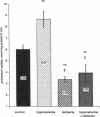Abstract
Hypoxemia is a major comorbid factor for permanent brain damage in several metabolic encephalopathies. To determine whether hypoxia impairs brain adaptation to hyponatremia, worsening brain edema, we performed in vitro and in vivo studies in cats and rats with hyponatremia plus either ischemic or hypoxic hypoxia. Mortality with hypoxic hypoxia was 0%; with hyponatremia, 22%; and with hyponatremia+hypoxia, 100%. Hyponatremia in cats produced brain edema, with a compensatory decrease of brain sodium. Ischemic hypoxia also resulted in brain edema, but with elevation of brain sodium. However, when ischemic hypoxia was superimposed upon hyponatremia, there was elevation of brain sodium with further elevation of water. Outward sodium transport in cat cerebral cortex synaptosomes was measured via three major pathways through which brain osmolality can be decreased. After hyponatremia, sodium transport was significantly altered such that brain cell osmolality would decrease: 44% increase in Na(+)-K(+)-ATPase transport activity (ouabain inhibitable); 26% decrease in amiloride-sensitive sodium uptake. The change in veratridine-stimulated sodium uptake was not significant (P > 0.05). When ischemic hypoxia was superimposed upon hyponatremia, all of the cerebral adaptive changes induced by hyponatremia alone were eliminated. Thus, hypoxia combined with hyponatremia produces a major increase in brain edema and mortality, probably by eliminating the compensatory mechanisms of sodium transport initiated by hyponatremia that tend to minimize brain swelling.
Full text
PDF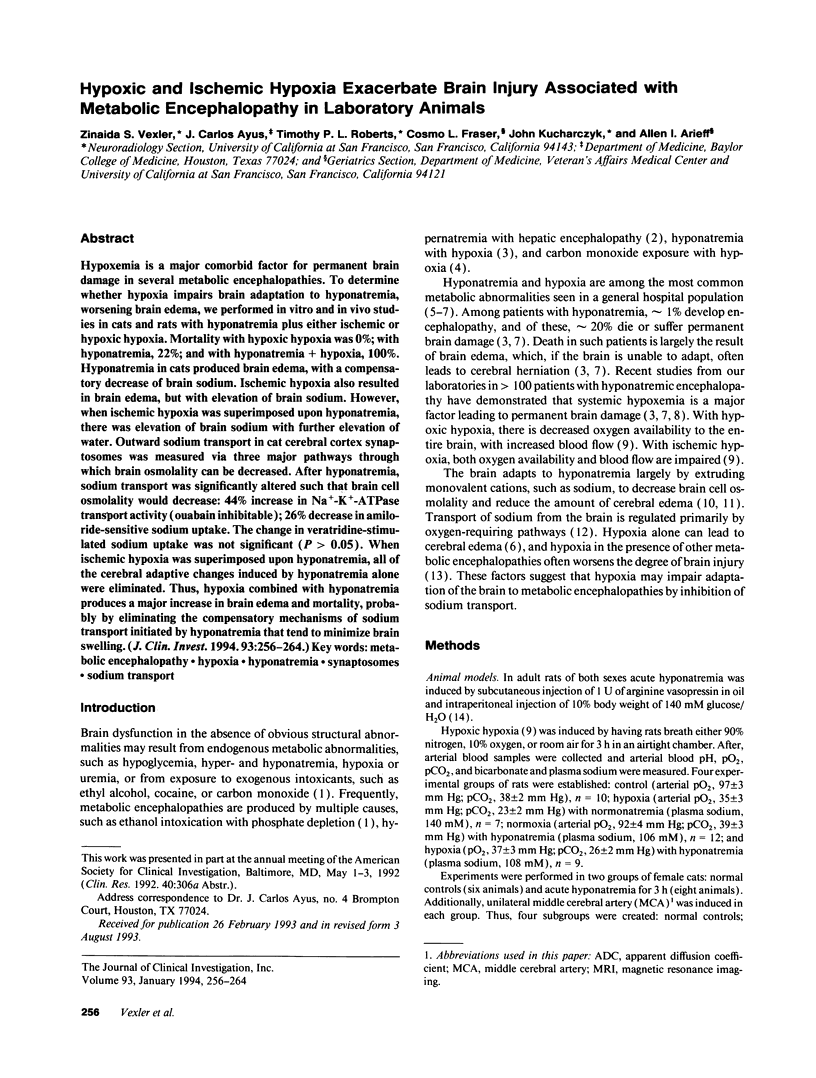

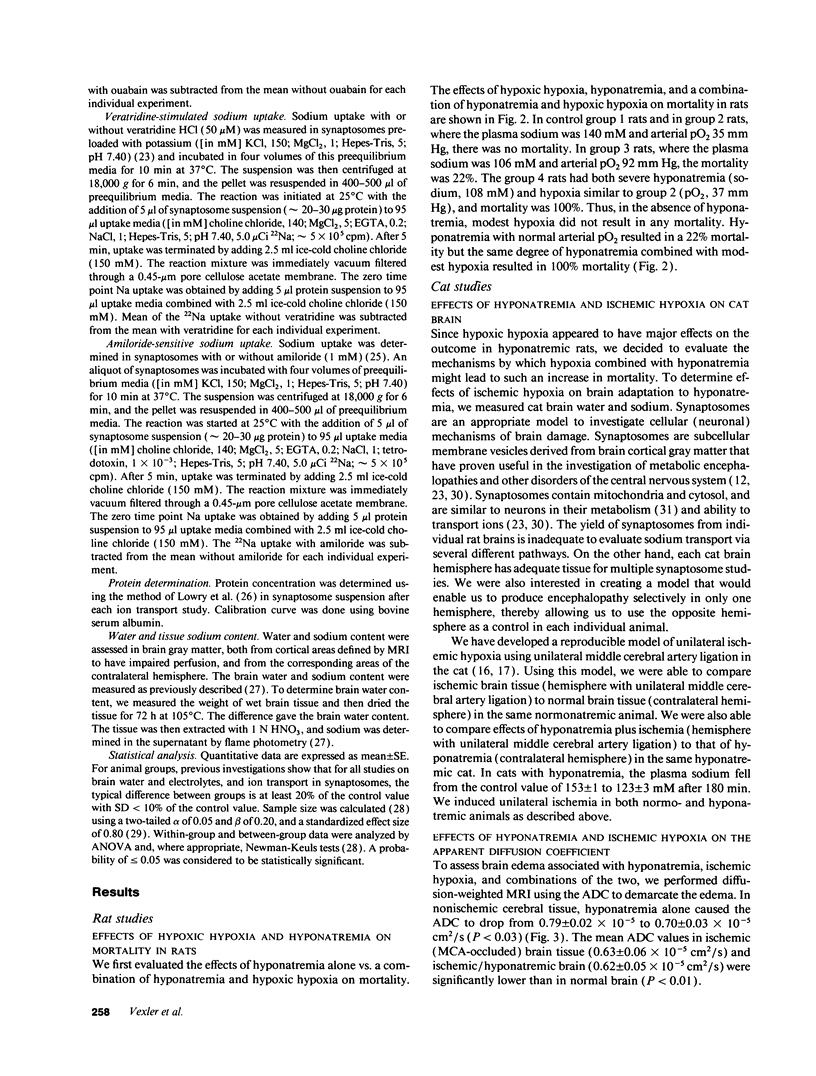
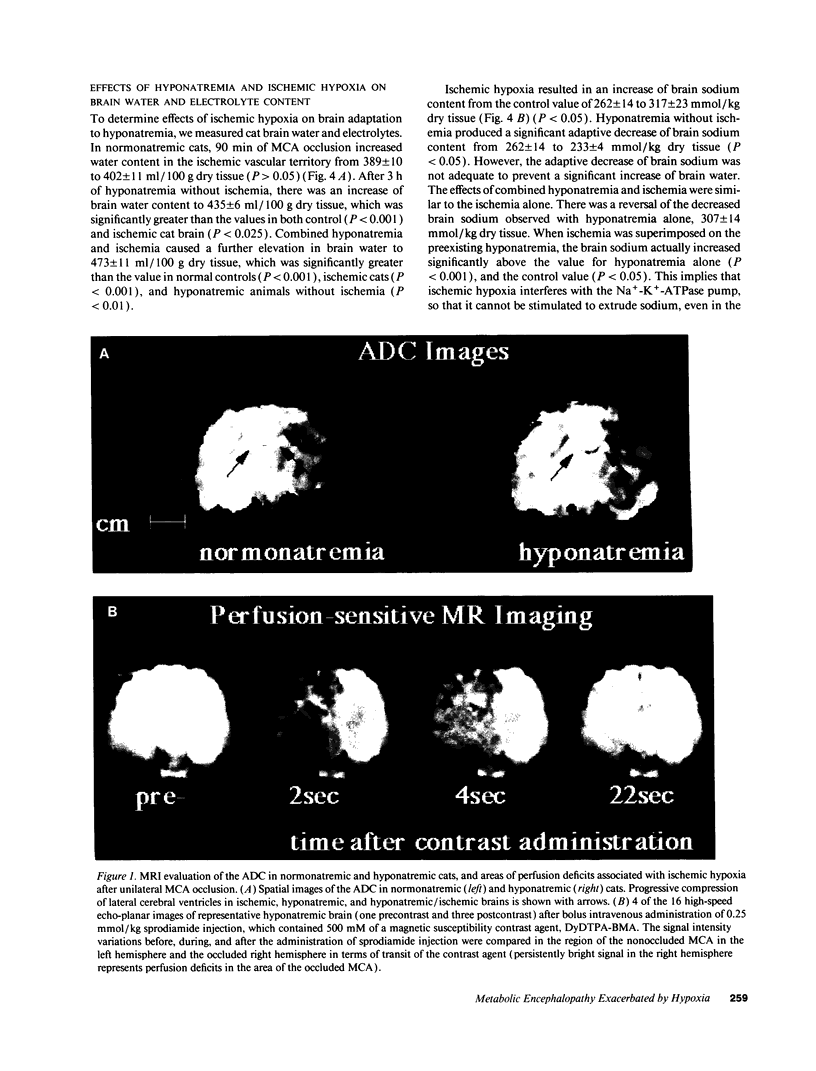

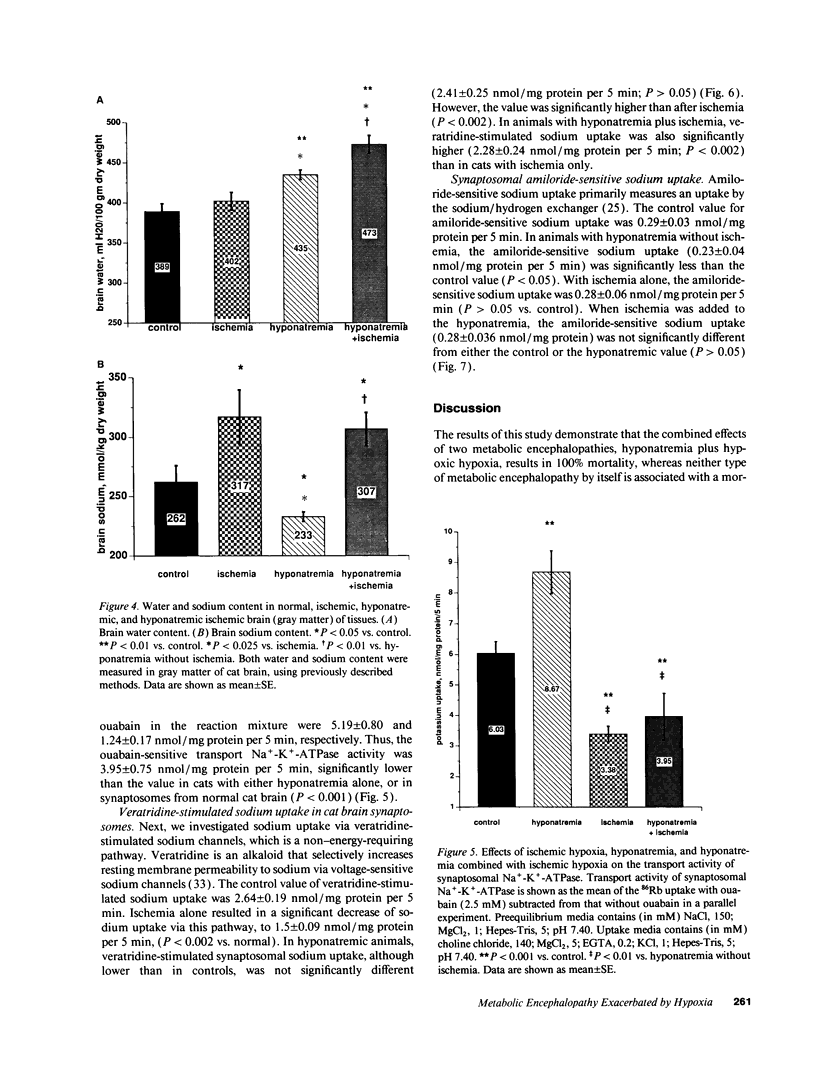
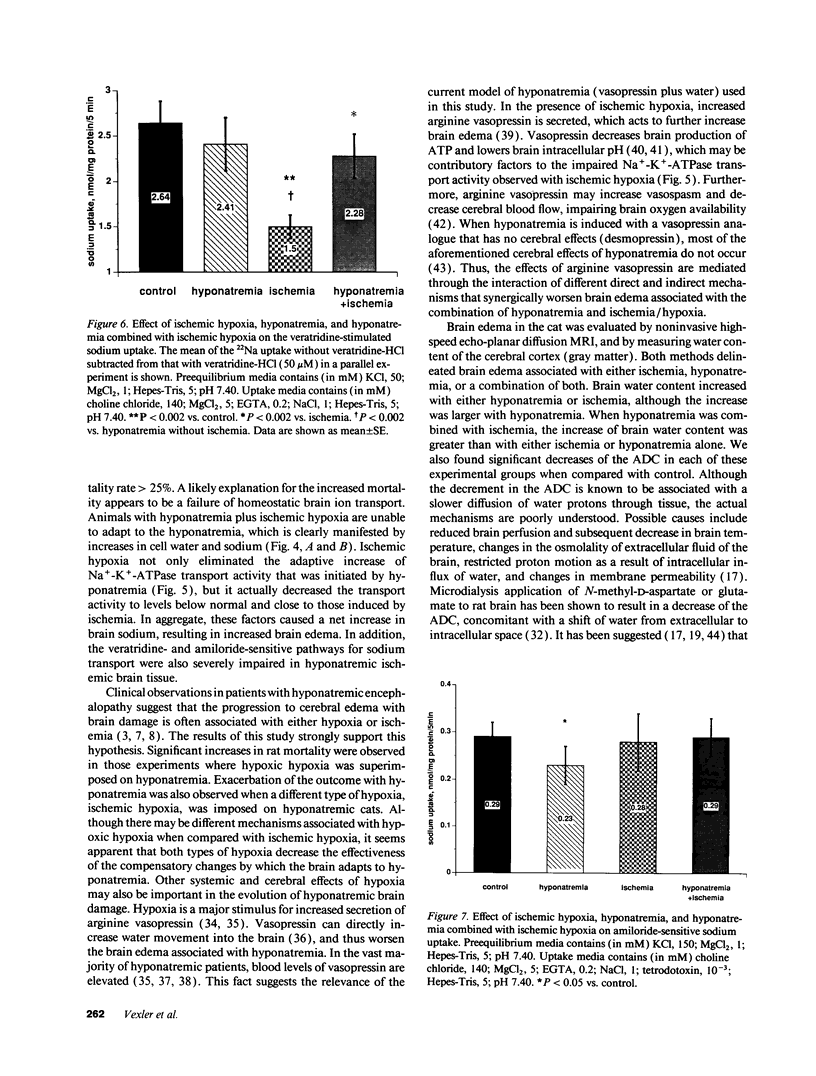
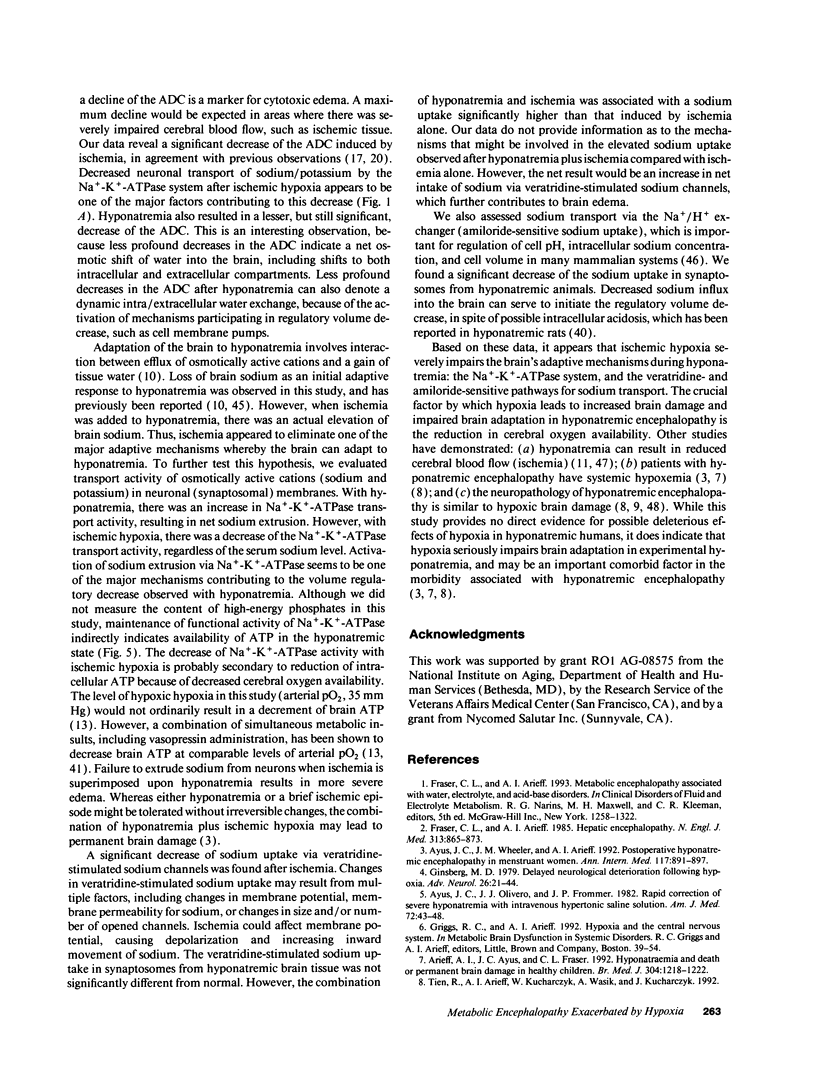
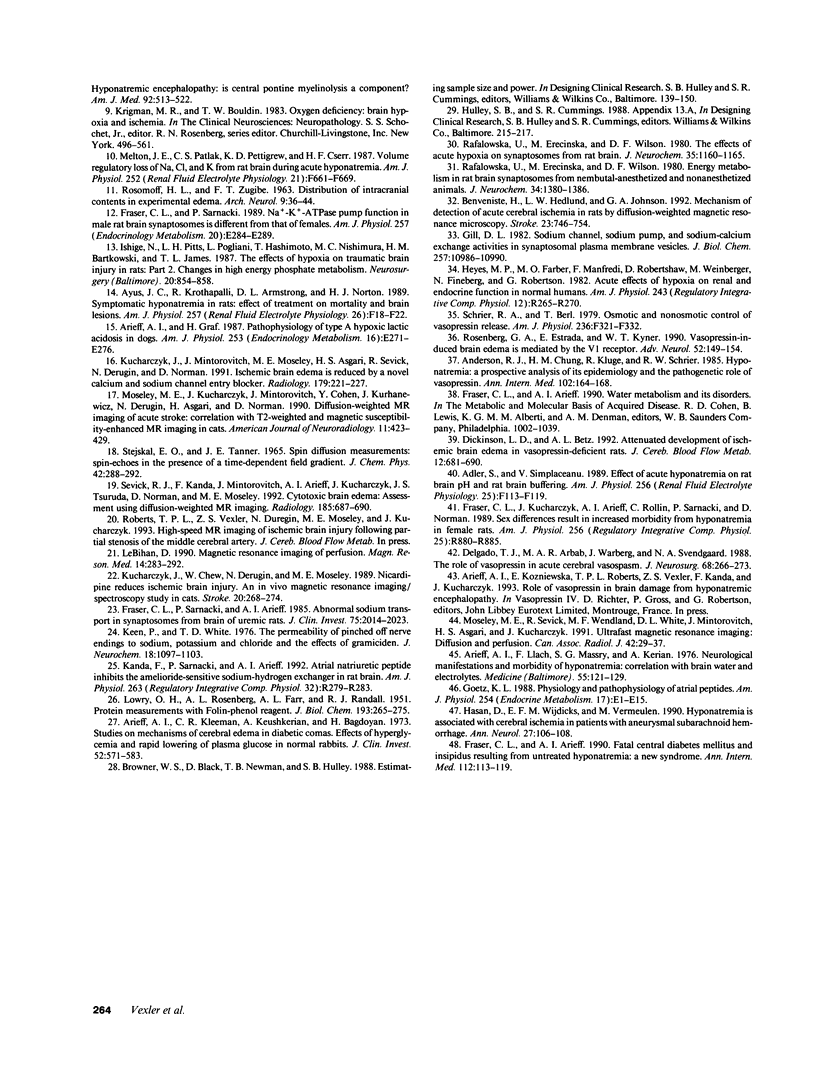
Images in this article
Selected References
These references are in PubMed. This may not be the complete list of references from this article.
- Anderson R. J., Chung H. M., Kluge R., Schrier R. W. Hyponatremia: a prospective analysis of its epidemiology and the pathogenetic role of vasopressin. Ann Intern Med. 1985 Feb;102(2):164–168. doi: 10.7326/0003-4819-102-2-164. [DOI] [PubMed] [Google Scholar]
- Arieff A. I., Ayus J. C., Fraser C. L. Hyponatraemia and death or permanent brain damage in healthy children. BMJ. 1992 May 9;304(6836):1218–1222. doi: 10.1136/bmj.304.6836.1218. [DOI] [PMC free article] [PubMed] [Google Scholar]
- Arieff A. I., Graf H. Pathophysiology of type A hypoxic lactic acidosis in dogs. Am J Physiol. 1987 Sep;253(3 Pt 1):E271–E276. doi: 10.1152/ajpendo.1987.253.3.E271. [DOI] [PubMed] [Google Scholar]
- Arieff A. I., Kleeman C. R. Studies on mechanisms of cerebral edema in diabetic comas. Effects of hyperglycemia and rapid lowering of plasma glucose in normal rabbits. J Clin Invest. 1973 Mar;52(3):571–583. doi: 10.1172/JCI107218. [DOI] [PMC free article] [PubMed] [Google Scholar]
- Arieff A. I., Llach F., Massry S. G. Neurological manifestations and morbidity of hyponatremia: correlation with brain water and electrolytes. Medicine (Baltimore) 1976 Mar;55(2):121–129. doi: 10.1097/00005792-197603000-00002. [DOI] [PubMed] [Google Scholar]
- Ayus J. C., Krothapalli R. K., Armstrong D. L., Norton H. J. Symptomatic hyponatremia in rats: effect of treatment on mortality and brain lesions. Am J Physiol. 1989 Jul;257(1 Pt 2):F18–F22. doi: 10.1152/ajprenal.1989.257.1.F18. [DOI] [PubMed] [Google Scholar]
- Ayus J. C., Olivero J. J., Frommer J. P. Rapid correction of severe hyponatremia with intravenous hypertonic saline solution. Am J Med. 1982 Jan;72(1):43–48. doi: 10.1016/0002-9343(82)90575-7. [DOI] [PubMed] [Google Scholar]
- Ayus J. C., Wheeler J. M., Arieff A. I. Postoperative hyponatremic encephalopathy in menstruant women. Ann Intern Med. 1992 Dec 1;117(11):891–897. doi: 10.7326/0003-4819-117-11-891. [DOI] [PubMed] [Google Scholar]
- Benveniste H., Hedlund L. W., Johnson G. A. Mechanism of detection of acute cerebral ischemia in rats by diffusion-weighted magnetic resonance microscopy. Stroke. 1992 May;23(5):746–754. doi: 10.1161/01.str.23.5.746. [DOI] [PubMed] [Google Scholar]
- Delgado T. J., Arbab M. A., Warberg J., Svendgaard N. A. The role of vasopressin in acute cerebral vasospasm. Effect on spasm of a vasopressin antagonist or vasopressin antiserum. J Neurosurg. 1988 Feb;68(2):266–273. doi: 10.3171/jns.1988.68.2.0266. [DOI] [PubMed] [Google Scholar]
- Dickinson L. D., Betz A. L. Attenuated development of ischemic brain edema in vasopressin-deficient rats. J Cereb Blood Flow Metab. 1992 Jul;12(4):681–690. doi: 10.1038/jcbfm.1992.93. [DOI] [PubMed] [Google Scholar]
- Fraser C. L., Arieff A. I. Fatal central diabetes mellitus and insipidus resulting from untreated hyponatremia: a new syndrome. Ann Intern Med. 1990 Jan 15;112(2):113–119. doi: 10.7326/0003-4819-112-2-113. [DOI] [PubMed] [Google Scholar]
- Fraser C. L., Arieff A. I. Hepatic encephalopathy. N Engl J Med. 1985 Oct 3;313(14):865–873. doi: 10.1056/NEJM198510033131406. [DOI] [PubMed] [Google Scholar]
- Fraser C. L., Kucharczyk J., Arieff A. I., Rollin C., Sarnacki P., Norman D. Sex differences result in increased morbidity from hyponatremia in female rats. Am J Physiol. 1989 Apr;256(4 Pt 2):R880–R885. doi: 10.1152/ajpregu.1989.256.4.R880. [DOI] [PubMed] [Google Scholar]
- Fraser C. L., Sarnacki P., Arieff A. I. Abnormal sodium transport in synaptosomes from brain of uremic rats. J Clin Invest. 1985 Jun;75(6):2014–2023. doi: 10.1172/JCI111920. [DOI] [PMC free article] [PubMed] [Google Scholar]
- Fraser C. L., Sarnacki P. Na+-K+-ATPase pump function in rat brain synaptosomes is different in males and females. Am J Physiol. 1989 Aug;257(2 Pt 1):E284–E289. doi: 10.1152/ajpendo.1989.257.2.E284. [DOI] [PubMed] [Google Scholar]
- Gill D. L. Sodium channel, sodium pump, and sodium-calcium exchange activities in synaptosomal plasma membrane vesicles. J Biol Chem. 1982 Sep 25;257(18):10986–10990. [PubMed] [Google Scholar]
- Ginsberg M. D. Delayed neurological deterioration following hypoxia. Adv Neurol. 1979;26:21–44. [PubMed] [Google Scholar]
- Hasan D., Wijdicks E. F., Vermeulen M. Hyponatremia is associated with cerebral ischemia in patients with aneurysmal subarachnoid hemorrhage. Ann Neurol. 1990 Jan;27(1):106–108. doi: 10.1002/ana.410270118. [DOI] [PubMed] [Google Scholar]
- Heyes M. P., Farber M. O., Manfredi F., Robertshaw D., Weinberger M., Fineberg N., Robertson G. Acute effects of hypoxia on renal and endocrine function in normal humans. Am J Physiol. 1982 Sep;243(3):R265–R270. doi: 10.1152/ajpregu.1982.243.3.R265. [DOI] [PubMed] [Google Scholar]
- Ishige N., Pitts L. H., Pogliani L., Hashimoto T., Nishimura M. C., Bartkowski H. M., James T. L. Effect of hypoxia on traumatic brain injury in rats: Part 2. Changes in high energy phosphate metabolism. Neurosurgery. 1987 Jun;20(6):854–858. doi: 10.1227/00006123-198706000-00006. [DOI] [PubMed] [Google Scholar]
- Kanda F., Sarnacki P., Arieff A. I. Atrial natriuretic peptide inhibits amiloride-sensitive sodium uptake in rat brain. Am J Physiol. 1992 Aug;263(2 Pt 2):R279–R283. doi: 10.1152/ajpregu.1992.263.2.R279. [DOI] [PubMed] [Google Scholar]
- Keen P., White T. D. The permeability of pinched-off nerve endings to sodium, potassium and chloride and the effects of gramicidin. J Neurochem. 1971 Jun;18(6):1097–1103. doi: 10.1111/j.1471-4159.1971.tb12038.x. [DOI] [PubMed] [Google Scholar]
- Kucharczyk J., Chew W., Derugin N., Moseley M., Rollin C., Berry I., Norman D. Nicardipine reduces ischemic brain injury. Magnetic resonance imaging/spectroscopy study in cats. Stroke. 1989 Feb;20(2):268–274. doi: 10.1161/01.str.20.2.268. [DOI] [PubMed] [Google Scholar]
- Kucharczyk J., Mintorovitch J., Moseley M. E., Asgari H. S., Sevick R. J., Derugin N., Norman D. Ischemic brain damage: reduction by sodium-calcium ion channel modulator RS-87476. Radiology. 1991 Apr;179(1):221–227. doi: 10.1148/radiology.179.1.2006281. [DOI] [PubMed] [Google Scholar]
- LOWRY O. H., ROSEBROUGH N. J., FARR A. L., RANDALL R. J. Protein measurement with the Folin phenol reagent. J Biol Chem. 1951 Nov;193(1):265–275. [PubMed] [Google Scholar]
- Le Bihan D. Magnetic resonance imaging of perfusion. Magn Reson Med. 1990 May;14(2):283–292. doi: 10.1002/mrm.1910140213. [DOI] [PubMed] [Google Scholar]
- Melton J. E., Patlak C. S., Pettigrew K. D., Cserr H. F. Volume regulatory loss of Na, Cl, and K from rat brain during acute hyponatremia. Am J Physiol. 1987 Apr;252(4 Pt 2):F661–F669. doi: 10.1152/ajprenal.1987.252.4.F661. [DOI] [PubMed] [Google Scholar]
- Moseley M. E., Kucharczyk J., Mintorovitch J., Cohen Y., Kurhanewicz J., Derugin N., Asgari H., Norman D. Diffusion-weighted MR imaging of acute stroke: correlation with T2-weighted and magnetic susceptibility-enhanced MR imaging in cats. AJNR Am J Neuroradiol. 1990 May;11(3):423–429. [PMC free article] [PubMed] [Google Scholar]
- Rafałowska U., Erecińska M., Wilson D. F. Energy metabolism in rat brain synaptosomes from nembutal-anesthetized and nonanesthetized animals. J Neurochem. 1980 Jun;34(6):1380–1386. doi: 10.1111/j.1471-4159.1980.tb11218.x. [DOI] [PubMed] [Google Scholar]
- Rafałowska U., Erecińska M., Wilson D. F. The effect of acute hypoxia on synaptosomes from rat brain. J Neurochem. 1980 May;34(5):1160–1165. doi: 10.1111/j.1471-4159.1980.tb09955.x. [DOI] [PubMed] [Google Scholar]
- Rosenberg G. A., Estrada E., Kyner W. T. Vasopressin-induced brain edema is mediated by the V1 receptor. Adv Neurol. 1990;52:149–154. [PubMed] [Google Scholar]
- Schrier R. W., Berl T., Anderson R. J. Osmotic and nonosmotic control of vasopressin release. Am J Physiol. 1979 Apr;236(4):F321–F332. doi: 10.1152/ajprenal.1979.236.4.F321. [DOI] [PubMed] [Google Scholar]
- Sevick R. J., Kanda F., Mintorovitch J., Arieff A. I., Kucharczyk J., Tsuruda J. S., Norman D., Moseley M. E. Cytotoxic brain edema: assessment with diffusion-weighted MR imaging. Radiology. 1992 Dec;185(3):687–690. doi: 10.1148/radiology.185.3.1438745. [DOI] [PubMed] [Google Scholar]
- Tien R., Arieff A. I., Kucharczyk W., Wasik A., Kucharczyk J. Hyponatremic encephalopathy: is central pontine myelinolysis a component? Am J Med. 1992 May;92(5):513–522. doi: 10.1016/0002-9343(92)90748-z. [DOI] [PubMed] [Google Scholar]







